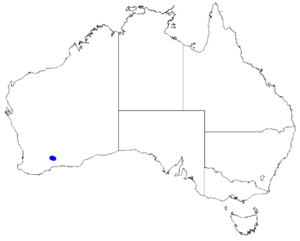Ironcap boronia facts for kids
Quick facts for kids Ironcap boronia |
|
|---|---|
| Conservation status | |
| Scientific classification | |
 |
|
| Occurrence data from Australasian Virtual Herbarium |
The Boronia revoluta, often called Ironcap boronia, is a special plant found only in the south-west of Western Australia. It is part of the citrus family, called Rutaceae. This plant is an upright shrub with leaves that have three parts and pretty pink or white flowers, each with four petals.
What it Looks Like
The Ironcap boronia is an upright shrub that can grow up to about 1 meter (3 feet) tall. Its young stems are covered with tiny, star-shaped hairs.
Its leaves are quite interesting. They are called trifoliate because they have three small parts, like a clover leaf. Each small leaflet is about 2.5 to 8 millimeters long and 0.5 to 1 millimeter wide. The leaves grow on a small stalk called a petiole, which is about 1.5 millimeters long. The edges of the leaflets are rolled under, and the leaflet at the end is longer than the two side ones.
The flowers are beautiful and grow one by one where the leaves meet the stem. They sit on a small, red, top-shaped stalk called a pedicel, which is about 0.5 to 1 millimeter long. At the base of the flowers, there are two or four small, narrow, triangular leaves called bracteoles, about 2.5 millimeters long.
The four sepals, which are like small leaves protecting the flower bud, are red and about 3 to 3.5 millimeters long. The four petals are either pink or white, egg-shaped, and about 6 to 7 millimeters long. The back of the petals is a bit hairy. Inside the flower, there are eight stamens, which are about 2.5 to 3 millimeters long. The top part of the stamens, called anthers, are heart-shaped and about 1 millimeter long. This plant usually flowers from July to October.
Naming the Plant
The scientific name Boronia revoluta was first officially described in 1971 by a scientist named Paul Wilson. He wrote about it in a science journal called Nuytsia. The plant he described was found by Kenneth Newbey near Lake King.
The second part of the plant's scientific name, revoluta, comes from a Latin word. It means "turned over" or "rolled back." This name likely refers to the way the edges of the plant's leaflets are rolled under.
Where it Lives
The Ironcap boronia grows in low eucalypt woodlands. These woodlands are found on the tops of ridges and small hills. You can find this plant in the Ironcap and Hatter Hill areas, which are north-east of Lake King in a region called the Mallee.
Protecting the Plant
The Boronia revoluta is considered an "endangered" species. This means it is at a high risk of disappearing forever. The Australian Government lists it as endangered under the Environment Protection and Biodiversity Conservation Act 1999. It is also listed as "Threatened Flora" by the Department of Environment and Conservation (Western Australia).
The biggest dangers to the Ironcap boronia are activities related to finding and digging up minerals, like mining. Efforts are being made to protect this special plant so it can continue to grow in Western Australia.


